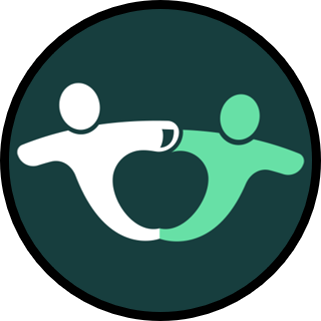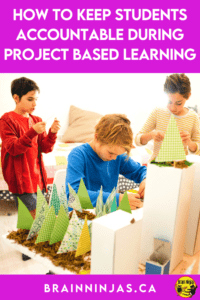
We love using project based learning as one teaching strategy to engage students. The challenge with this type of learning is keeping students on track. Nothing is worse than getting to a deadline and discovering none of the students are done. So, how do we keep our students accountable during project based learning?
Create Clear and Visual Milestones for Project Based Learning
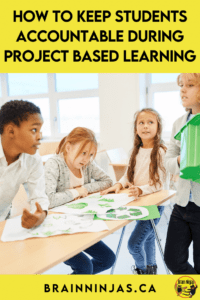
Start by setting your students up for success. They are not going to be able to manage their time perfectly the first time you do a project. Start small with clear and visual milestones. Checklists, charts, and date reminders that are clear and visible will help your independent workers stay on track.
Students who need more support will need more help than knowing all the deadlines.
Time management is not a skill that comes naturally to all students. Break down the assignment and schedule the amount of time you think students will need to do each step. Then double it. They will always take longer than you think they will need and there will always be interruptions that shorten the amount of time.
To get started planning out your next project-based learning activity, grab this planning guide from our Resource Library. The Project-Based Planning Guide can be found in our Resource Library, along with many other general classroom forms to help you organize your classroom, or we can send it to you when you sign up for our email list.
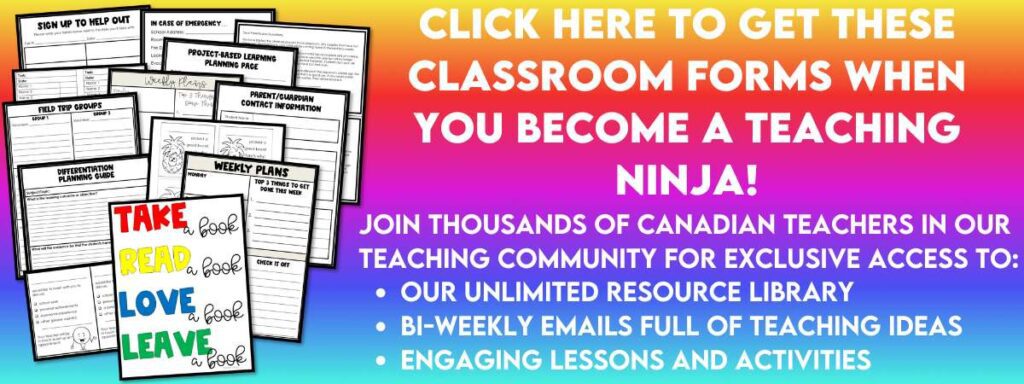
Keep Students Accountable Before They Get Behind
One of the most challenging things is keeping track of all your students and where they are. It’s hard to catch up with the ones that are behind if you don’t know where everyone is. It’s tempting to get sucked into other tasks while students are hard at work with their projects, but we encourage you to use this time to check in with everyone.
Walk around and talk to students as they are working. Observe where they are in their project. When you notice lots of students struggling with the same thing, stop and teach the skill to the whole class. It will be faster than trying to teach it one-on-one each time the problem arises.
One way we keep track is to use a simple Name Checklist. This list is small and makes it easy to carry around while students are working. You can grab a copy in the Resource Library, or we can send one directly to you, along with other classroom forms.
Create or Use Engaging Project Based Learning Tasks
We use project based learning tasks for science and social studies most often, but they can be used with any subject. Project based learning means students are learning skills, knowledge or attitudes as they work through a unit. This is different than a project at the end of the unit to show what a student has learned. Read more about it in our post, The Reasons for Project Based Learning.
Here are some of our favourite project based learning activities:
Design a Carnival Attraction: This activity has students design carnival attractions that use different simple machines to operate. There is a lot of designing and testing with this activity.
Design A Fur Trade Post: This activity has students pretend they are working with an archaeologist or anthropologist to find locations where fur trades may have been in the past. Students need to use historical and geographical thinking to write a report and create a visual representation of the fort.
Design a Homestead: In this activity, students are documentarians making a presentation about homesteads across the prairies at the beginning of the twentieth century. Students will get to make a visual representation and write about life on a homestead.
Design an Electrical Gameboard: Students use what they have learned about electricity and make a game where getting the correct answer results in a complete circuit. They get to be creative in coming up with how their game works or the topic of the questions.
Design a Plant Activity: Students get to create their own fictional plant and use everything they know about plants. They can diagram the plant, its life cycle, and explain how it reproduces.
Design a Weather Forecast: In this activity, students use different elements of weather to design a weather forecast for their local area. This is a fun one since students get to perform or record their forecasts.
Design a Weather Instrument: For this activity, students learn about the different weather devices used to measure weather. They get to build one and explain how it works.
Use Tools to Scaffold the Steps for Project Based Learning
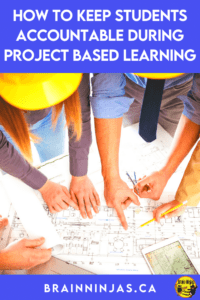
Some of your students will need tools to make finding, reading and writing information easier.
Many of our students use Google Read&Write when doing online research. It can look up words, take notes and even read the text to students. It’s free for teachers and you can try a 30-day free trial subscription. Many Google School districts already offer it, so check to see if it’s available for you.
If that is not an option, we have used other tools in the past: Natural Reader and Rewordify, which can do some of the reading help. For voice recording, our students use Vocaroo or Voice Recorder on the Google Chrome Store.
Some students will need the task broken into each individual step. Give students an accountability partner who can check the little steps. When a student completes a few little steps, have them check in with you. Celebrate any progress. The point of project based learning is the learning that happens along the way. It’s not about the finished project.
You might have students who will need the project adapted or modified due to their learning needs. This might mean reducing the amount of work, reducing the amount of independence or providing scaffolds that will help your student. If you are creating a project for your students, consider starting with a simple project that everyone will be able to do successfully. This will build confidence and help your students learn where to start with projects like these. Each one you do through the school year can become a little more complex as students get better at completing the work.
Work With Your Students
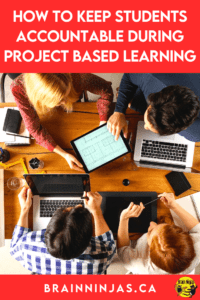
As students are working on their projects, sit with them. Talk about what they’re doing or what you can do to support them. Keep notes so that you can plan minilessons or target specific skills.
If you have a few students who need extra direction during a project, bring them together in a small group. Have them help each other by problem solving together or brainstorming ideas. This will let your independent workers stay focused on their own work while the students who need more help get that support.
Independent workers also need some of your attention. Meet with independent workers to chat about where they are in their projects. They won’t need as much coaxing to talk about where they are or what they need, but they love to have your undivided attention, too.
Record Progress As You Go
As students are working, they should be documenting what they are doing. Pedagogical documentation is a concept used by many kindergarten and early learning teachers, but it has a place in upper elementary, too. Basically, it means recording the learning as it’s happening as part of the overall assessment. To read more, check out this article by Ontario Education.
This is not a big amount of work. Each day, students document what they’ve accomplished with the project. This could be a quick list of items, a photo, or a quick video showing what they have done for the day. This should not be perfect documentation, but just generally where they are in the process. They can record any questions they have or ideas about where they want to go next.
By recording their progress, we, the teachers, get two things from it. We can make sure students are getting somewhere with their projects. This makes it easier to stay on top of stragglers. Second, we can use the documentation to assess how well students have mastered concepts.
Another way we do this is just through a quick share at the end of a work period. We voice-record students as they give a quick update on their progress if they haven’t documented their own progress. Students can ask classmates for assistance or ideas during this time.
Limit the Choices
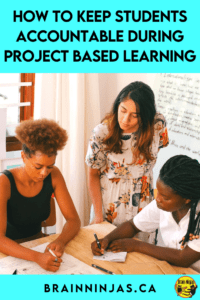
If the project has unlimited possibilities, it can create problems for students who can’t see a path forward. Some students need the list of choices limited or chosen for them. Otherwise, they spend all their working time jumping from task to task without accomplishing anything, or they just do nothing because they don’t know where to start.
Choices can include the topics, the tools, the format, or the mode of presentation. To learn more about how we use choices in our classroom, you should read How to Differentiate Using Choices.
We recommend giving two choices where both choices will work for the student. Eliminate anything that is too complex or requires a new skill set because that will stall a student. Let them use tools or strategies they are already comfortable with.
This process starts with a simple conversation where we help the student make decisions in one sitting. This way, they can focus on the work instead of the decisions.
Project based learning can be extremely effective and highly engaging. It can also be a complete disaster if there’s no accountability for your students. It’s important to keep yourself accountable as your students work. You should know where each student is during the project.
What other ways do you keep your students accountable when they are doing project based learning? Let us know because we’d love to hear your strategies.






